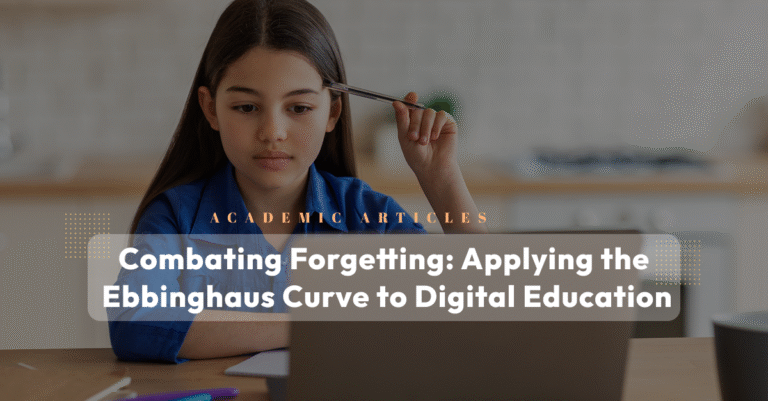Forgetting is something psychologists have studied for over a hundred years. One of the first to explore it in depth was Hermann Ebbinghaus, who introduced the idea of the “forgetting curve.” This concept shows that we forget information quickly after we first learn it—unless we actively review and reinforce it.
With the rise of online schools and virtual classrooms, these insights from cognitive psychology are more relevant than ever. Digital learning has made education more flexible and widely accessible, but one key challenge remains: how to help students truly remember what they learn.
Ebbinghaus’s research in the late 1800s, based on experiments he conducted on himself, revealed that without regular review, knowledge fades rapidly. His work continues to shape how we think about memory and long-term learning, especially in today’s digital education landscape.
Modern educational technology offers a powerful way to fight the effects of the forgetting curve. By using research-based teaching methods—especially those that involve smart repetition—we can help students retain information more effectively.
We’ll look at how digital learning platforms can apply techniques like spaced repetition and retrieval practice, both rooted in Ebbinghaus’s work, to strengthen memory and boost long-term learning outcomes.
The Ebbinghaus Forgetting Curve

Ebbinghaus showed that we forget new information quickly, often losing up to 70% of it within just 24 hours. He also discovered something important: reviewing the material at carefully timed intervals can greatly improve how much we remember over time.
This idea, called spaced repetition, is now a key principle in memory research. Instead of cramming, learners review content after a day, then a few days later, then a week later, and so on. This method helps flatten the forgetting curve and strengthens long-term retention.
These insights are especially valuable for online learning, where students often learn at their own pace and on their own schedule. By building spaced repetition into digital courses, we can help learners retain more and forget less.
Digital Education and Memory Retention

One of the most significant advantages of digital learning platforms is their ability to support repetition-based strategies.
Traditional classrooms often face time and schedule limitations.
Online systems can track student progress, customize learning materials, and automatically schedule review sessions based on each learner’s needs. This makes it much easier to apply techniques like spaced repetition in a consistent and personalized way.
Key technologies and methods that can support the fight against forgetting include:
- Spaced Repetition Algorithms: Systems like Anki, SuperMemo, and Duolingo employ algorithms based on the forgetting curve to present information just before it is likely to be forgotten. These tools personalize review schedules depending on individual user performance, maximizing efficiency.
- Adaptive Learning Platforms: AI-driven platforms can analyze learning behaviors and adjust the timing and difficulty of content delivery. By detecting patterns of recall and forgetting, these systems can proactively reintroduce material to reinforce memory at optimal intervals.
- Microlearning and Modular Content: Breaking down content into smaller, easily digestible modules allows for more frequent and targeted repetition. When combined with push notifications or daily learning goals, microlearning helps establish a routine that naturally embeds spaced review.
- Gamification and Engagement Mechanics: Gamified elements such as streaks, badges, and challenges can motivate learners to return regularly to the platform, creating natural opportunities for spaced repetition without explicit instruction.
Case Studies and Implementation Examples
Several platforms have demonstrated the practical benefits of incorporating Ebbinghaus-inspired repetition strategies:
- Duolingo uses a “strength bar” for vocabulary words, indicating how recently and effectively each term has been practiced. The system encourages users to “strengthen” fading knowledge through review.
- Khan Academy offers mastery-based learning pathways, where students periodically revisit previous topics to ensure long-term understanding, reinforced by AI-driven recommendations.
- Quizlet has introduced features like “Smart Study Plan,” which schedules review sessions based on spaced repetition science.
Applying the Ebbinghaus Curve in Online K12 Education
By integrating insights from cognitive science, such as Ebbinghaus’s forgetting curve, these schools can design learning experiences that actively support memory retention.
This is especially important for younger students, whose study habits and executive functioning skills are still developing.
Online platforms allow for intentional, research-based interventions to help students remember what they learn, something that traditional classrooms often struggle to do consistently.
Here are several reasons why online K–12 schools are well-positioned to tackle the challenge of knowledge retention.
Building Repetition into the Curriculum Design
Online K–12 programs can intentionally structure their lesson plans to revisit core concepts at strategic intervals.
Instead of treating each unit as an isolated block, curricula can be designed to loop back to earlier material through warm-up activities, cumulative quizzes, and cross-topic projects.
For example, a math course might reintroduce fractions during a geometry unit, reinforcing earlier learning in a new context.
Personalized Review Schedules through Learning Management Systems (LMS)
Online schools can automate personalized review prompts based on student performance.
When a student struggles with a topic, the system can schedule a review session days or weeks later, aligning with the optimal intervals suggested by the forgetting curve.
Frequent Low-Stakes Assessments
Regular, low-stress quizzes and practice tests are a great way to help students remember what they’ve learned. These quick checks act like built-in review sessions, strengthening memory without causing test anxiety.
In online learning, these assessments can be automatically created and adjusted to match each student’s skill level. This means students get the right kind of review at the right time, which is especially helpful in subjects that build over time, like math, science, and languages.
Teacher Dashboards and Data-Driven Interventions
Online K–12 platforms can track detailed data on how students learn and engage. Teachers can use this information to spot when a student is likely to forget specific topics and step in with the right support.
This might mean assigning a quick review, slowing down the pace of a lesson, or offering one-on-one help, just when the student needs it most. With this kind of smart intervention, students get the help they need before learning gaps grow.
Parental and Guardian Involvement
Online K–12 education often includes more involvement from parents compared to traditional classrooms. Schools can make the most of this by giving parents simple tools and reminders to help reinforce learning at home.
For example, sending notifications with suggested review activities or quick reminders—based on spaced repetition—can turn memory practice into a team effort between school and home. This kind of collaboration helps students retain more and stay on track.
Project-Based Spiral Learning
Spiral learning—where students revisit topics over time with added depth—helps reinforce understanding while building new skills. This approach can be especially practical in digital learning environments.
Online platforms can track each student’s progress through these learning spirals, ensuring that review happens naturally as part of the learning process, not just as a fix when something is forgotten. This keeps knowledge fresh and builds a stronger foundation for future learning.
Challenges and Considerations
While repetition strategies are powerful, their implementation must balance cognitive load, learner motivation, and the risk of redundancy. Over-repetition or poorly timed reviews can lead to disengagement.
Moreover, repetition must be meaningful. Reviewing content in varied contexts and formats (e.g., quizzes, flashcards, simulations) enhances the richness of memory traces and prevents rote memorization.
Another consideration is inclusivity. Adaptive systems must be designed to accommodate diverse learning styles, paces, and accessibility needs to ensure equitable educational experiences.
Conclusion
Combating forgetting in digital education is both a challenge and an opportunity. By applying Ebbinghaus’s insights into the design of online learning experiences, educators and developers can create more effective, engaging, and enduring educational outcomes. The future of learning lies not just in delivering content, but in delivering it again—and again—at the right time, in the right way.
Share, Discuss, or Ask
Do you have a child in an online school, or are you considering enrolling your child in one? We’d love to hear about your experiences. Let us know what has been or may be decisive in the dilemma of traditional vs. online.
If you have questions, please visit us at EduWW or email [email protected].



